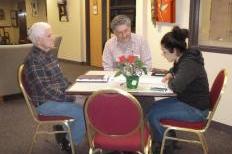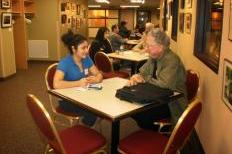







“Dialogue Across the Ages,” a program run through the Work and Learn Center on the east side of Madison, that brings high school students and older adults together for four sessions in the fall semester.
The Work and Learn Center is an alternative program in the Madison Metropolitan School District for student at risk of not graduating that combines academics and vocational placement and allows the students to attain their high school diploma. Dialogue Across the Ages provides a forum at Madison’s Senior Center for these students, who have often faced many struggles early in life, and senior volunteers to simply…talk.
The benefits of the program, however, reach far beyond just talking, its organizers said. The two age groups learn and grow from each other; the students gain life advice and a push in the right direction, while the seniors gain a whole new perspective on the younger generation in general.
Erik Shager, a teacher and Work and Learn for nearly 20 years, leads the sessions.
“I’m teaching a class ranging in age from 18 to 80,” he said. “It’s kind of cool.”
Dialogue Across the Ages began seven years ago when the previous coordinator of Work and Learn, Janet Weitz, took a job at the Madison Senior Center after she retired. Going from working with students to working with seniors, she had the idea to create a program where the two groups could talk and hopefully gain life advice. She and Shager developed the program that, according to students and seniors alike, has had much success.
When asked what the students get out of the program, one of the newest volunteers 66-year-old Nancy Dunham responded, “A second chance at life, I think.”
Paul Buckalew, 80, who was a teacher for 34 years, has been with the program from the beginning. “I think it’s a wonderful thing, I really do,” he said. “I just value that you need an education today. It’s nice to see they’re getting a new start.”

Through the Work and Learn program, Yang became employed through Operation Fresh Start doing construction and earned his high school diploma.
“I thought I knew everything, I thought I was right all the time, but I was wrong,” Yang said. When he entered the program, he was uncomfortable around his classmates at first, but then grew tight bonds with them and his teachers.
“Making all those friends, there’s no point in skipping school anymore,” he said. “You won’t be bored, you can talk to friends, and they can help you; Erik can help you.”
Making connections with others is a key in helping these teenagers’ success. Shager related the idea in education that students need one significant adult. “I think the students that come to Work and Learn get more than one.”
The older adults the students interact with during Dialogue Across the Ages can share life advice for students going through hard times, because they’ve already lived through many of their hardships.
“That age diversity is just fantastic,” said Shager. “You can have somebody that’s lived through quite a bit of history, and then young people who are out in the world right now. Getting those two groups together can be pretty amazing.”
Class sizes are small, with 12 students in their final semester of the alternative program and 12 volunteers. Volunteers are able to openly share their life experiences with the students.
Nancy Dunham was a young mother in college at the age of 19, and she’s now able to share her struggles these students and girls in the program who were also mothers “so that they know that life is hard for people.”
“I could be honest and say my younger years were not the easiest,” she said. “People of all generations have struggles. We’re not aliens, right? We’re just people. We made our own mistakes.”
“It’s not always easy, you know,” said fellow volunteer Buckalew. “I can tell from my own experience, I just relate how I got my education.”
According to Yang, he learned a lot from the seniors that he didn’t expect, talking about topics like life experiences and relationships.
“The seniors said some wise words that touched my heart and made me realize a lot of things,” said Yang. “It pushed me, motivated me to finish Work and Learn and to just try to be successful in life.”
Shager said that in the beginning of the program each year, the students think they’re helping the volunteers and vice versa. “But what ends up happening is you see both groups learning and growing and that’s probably the coolest part about it.”
As Sally Stein, who coordinates the senior volunteers, said “It goes both ways.” Students taught the seniors about cell phones and the benefits of texting, while providing different perspectives on technology in general.
“I think people probably slid more towards the middle because they could see on both sides how it could all work out,” said Shager regarding a spontaneous conversation about technology during one of the sessions. “That’s the beauty of that discussion.”
For Stein the most rewarding part about the program is how the seniors come to view the younger generation.
“Reading all the disparaging remarks you see about kids, it’s really good to see that we can kind of change people’s opinion on that and it’s not only their grandchildren who are great kids, but there’s a bunch of them out there.”
Shager said, “I don’t want to stereotype the students that we have, if I did I’d say all good things.” However, these students have had trouble in their lives and school and may not be used to praise. “And then to hear, it happens every session, where the volunteers will just comment on what great kids they are. That’s awesome,” he said.
“They see that people really care about them and want them to learn,” said Buckalew. “Some of them are actually really bright.”
The seniors help the students write their graduation speeches, which can be an emotional affair for the kids who worked so hard to graduate. Dunham was impressed by their confidence and poise. “I came away from it thinking, ‘My goodness they’re such great kids. This is a great program,’” she said.
Although students and seniors have different perspectives on certain issues like technology, they can relate to each other more often than not.
Dunham, who even noticed a generation gap between herself and the other volunteers, said, “In fact, it was maybe not often that we weren’t agreeing with the students, but maybe I wasn’t agreeing with the other volunteers,” she said. Disagreement wasn’t based on age differences as much as it was based on individual differences.
Shager believes the seniors and students have a lot more in common than they’re willing to admit at times, and the more they talk the more they realize that.
He stressed the importance of memorable learning experiences that people carry with them throughout their lives, and said, “I’m sure students would point to this. I know they would.”
Much of the program’s success can be attributed to Shager, who Stein refers to as “magical” in his teaching. Yang and many of the students formed a close bond with Shager, and Nancy said he’s “remarkable.” According to Buckalew, he insists upon the students’ success, going to get them if they don’t come to class.
Shager cares deeply about the program, saying he still gets nervous before every session. “It’s hard to sleep at night making sure everything’s going to go accordingly,” he said. But according to him, things always do go accordingly, because of the good people in the room.
“I get more out of it than anybody. I can’t believe I get paid,” he said.
Shager plans the Work and Learn Curriculum to stress the point of human interaction. In the first semester of the Work and Learn program, students are placed with an elementary teacher to help teach children, which provides them with both a sheltered environment and responsibility for the young kids. According to Shager, the elementary school kids don’t know if the high school students are 10 years old or 80, only that they’re a big person. To them, age doesn’t matter.
At the end of the program, students interact with seniors through Dialogue Across the Ages, and are able to witness the full life cycle. Again, the theme that age isn’t such a big deal emerges. Both the kids’ and older adults’ needs are very similar: “There’s that need for interaction,” Shager said.
That need for communication carries into the Work and Learn students’ lives. According to Yang, many teenagers don’t have anyone to really talk to. A huge part of success is just being able to make connections with others, regardless of age.
“When you live, you find people are the same the world over,” said Buckalew. “They just need a little love and understanding.”
|
|
|
Welcome to the Madison Commons, a website designed to provide news and information about all of Madison's neighborhoods and a crossroads for the discussion of community issues. The name comes from the idea of a village commons, a place for news, talk, debate, and some entertainment, too, that's open to everyone.
All rights reserved. Read more about the Madison Commons and its partners.

